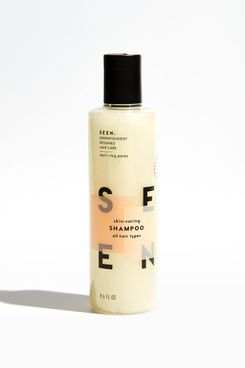
A few years ago, out of nowhere, I developed painful, cystic acne on the sides of my face, along the hollows of my cheeks. I followed all of my standard, acne-fighting protocol in an attempt to clear it up — I used salicylic-acid-based serums and toners, covered myself in pimple patches, and even went so far as to switch my pillowcases every other day — but nothing seemed to work.
After about six months, I ran out of my shampoo and conditioner and decided to try out a new brand (Olaplex’s shampoo and hair mask, for those who are wondering). And to my surprise, within two or three weeks of using these new hair products, the acne cleared up entirely. It suddenly dawned on me that all this time my hair care had been responsible for my painful breakouts. I hoped this was a sort of anomaly, but according to Dr. Loretta Ciraldo, a board-certified dermatologist and founder of skin-care brand Dr. Loretta, a majority of her patients with adult acne can relate their breakouts, at least in part, to their hair care.
One method of detecting hair-care-related acne, according to Dr. Loretta, is through face mapping — standard or hormonal acne tends to pop up in the center of your face, but acne triggered by hair products tends to occur around the outer rim, in areas such as your forehead, sides of your face, and hairline. Dr. Loretta explained that there’s no one ingredient collectively responsible for all hair-care-related breakouts, as it can vary from person to person, depending on their skin type. “Interestingly, I have noticed that the combination of sulfates and oils — specifically moroccan or argan oil — have been the culprit in quite a few incidents,” says Dr. Loretta. “When those ingredients are combined in hair care I’ve found a sort of synergism occurs, and I suspect it makes the formula penetrate deep into your skin and clog your pores.”
But here’s the great paradox of hair-care-related acne: The things that are quite possibly wreaking havoc on your skin (such as rich oils and thick emollients) are the best ingredients for your hair — not only can they deeply condition, they can also help repair damaged follicles. But the good news is you needn’t sacrifice the health of your hair in order to prevent zits. According to Dr. Loretta, there are tons of tips and tricks, as well as supplementary products that you can incorporate into your preexisting routine, to keep both your skin and hair happy. Below, a list of cleansers, shampoos, and leave-in treatments that can help prevent hair-care-related breakouts.
The simplest prevention method is to thoroughly cleanse your skin in the shower, right after you’ve shampooed and conditioned. Dr. Loretta explained that while any cleanser is better than nothing, you may have better luck keeping breakouts at bay by using a cleanser formulated specifically for acne-prone skin types. Panoxyl’s 10 percent benzoyl peroxide cleaner is a tried-and-true dermatologist pick, as the high concentration of BP effectively works to kill bacteria in the skin and control oil production. As someone with dry and sensitive skin myself, I completely understand if the words “high concentration benzoyl peroxide” are a red flag for you — but as it’s a wash-off treatment, it dramatically reduces the possibility of irritation while ensuring you’re delivering the acne-fighting benefits to the affected area.
If following up with a cleanser isn’t cutting it and your acne persists, Dr. Loretta recommends trying this Neutrogena T-sal shampoo with 3 percent salicylic acid. She’s found that most of her clients are very attached to their conditioner or hair mask and less so their shampoo (as the conditioner is typically what’s doing the heavy lifting as far as moisturizing and repairing the hair). In these cases, Dr. Loretta recommends subbing in this shampoo. “If the issue at hand is that residue from your hair care is tricking down from your scalp to your face, having a formula that actually incorporates acne-fighting ingredients — such as salicylic acid — in their hair care is a great way to kill two birds with one stone.”
Dr. Loretta says she’s also had incredible luck with acne-prone patients who “cut” their preexisting conditioner or hair mask with this leave-in treatment from Infusium. The Infusium product (which is technically a leave-in treatment but Dr. Loretta swears works well as a conditioner) is extremely non-comedogenic, meaning it’s free of any remotely pore-clogging ingredients and is unlikely to cause any sort of skin reaction or breakout.
Dr. Loretta explained that on its own the formula is not all that hydrating, but when it’s mixed in with your current conditioner, it’s able to dilute its richness. By doing so, the Infusium treatment lessens the comedogenic nature of the formula without sacrificing your conditioner’s hair-quenching benefits. Dr. Loretta explained that this has been an extremely helpful trick for her patients that are very attached to their conditioner or hair mask but are suffering severe breakouts as a result. “It changes the formula just enough to reduce its comedogenic nature, but it still gives your hair the same results as it did before,” she explained. Dr. Loretta recommends using a 1:1 conditioner–Infusium treatment pump ratio and mixing it in the palm of your hands.
If you’re not attached to your current shampoo or conditioner, Dr. Loretta says an easy option is to switch to a totally non-comedogenic brand. The dermatologist behind the SEEN products wanted to formulate a line of hair care suitable for a wide range of skin types — from eczema prone to acne prone to generally sensitive. It’s free of any potential acne triggers (such as rich oils and sulfates) but still incorporates gold-star, hydrating ingredients such as squalane to lock in moisture. After using SEEN for three months, Strategist writer Leah Muncy saw the acne around her hairline and behind her ears disappear. The conditioner is “soft and smooth without coating [my hair] with a slippery, pore-clogging film,” said Muncy.
The Strategist is designed to surface the most useful, expert recommendations for things to buy across the vast e-commerce landscape. Some of our latest conquests include the best acne treatments, rolling luggage, pillows for side sleepers, natural anxiety remedies, and bath towels. We update links when possible, but note that deals can expire and all prices are subject to change.












